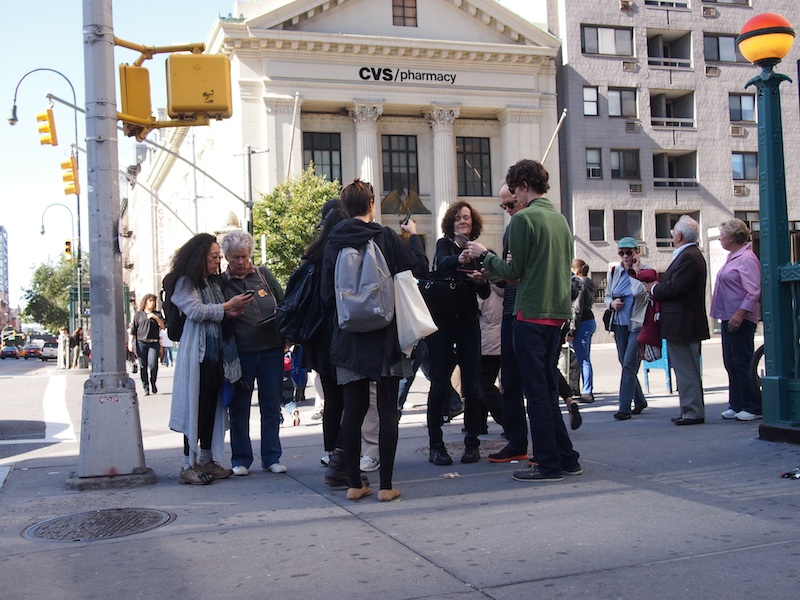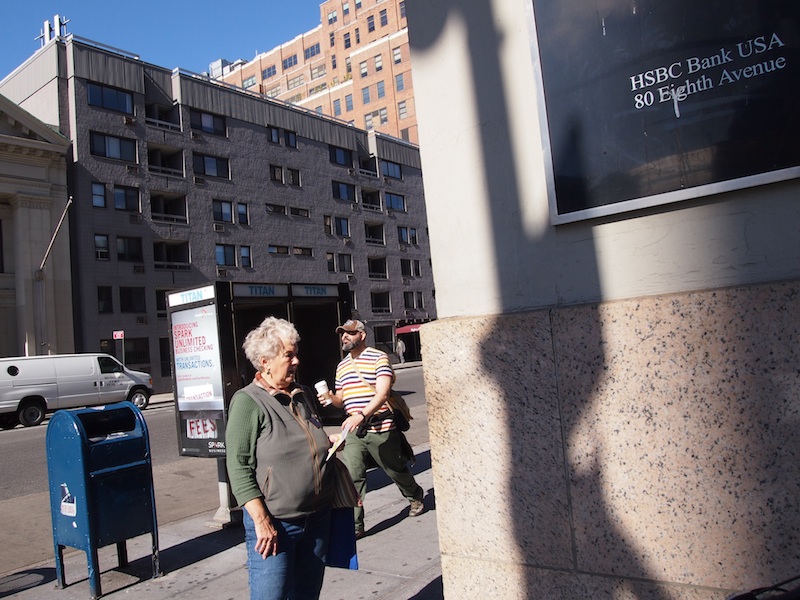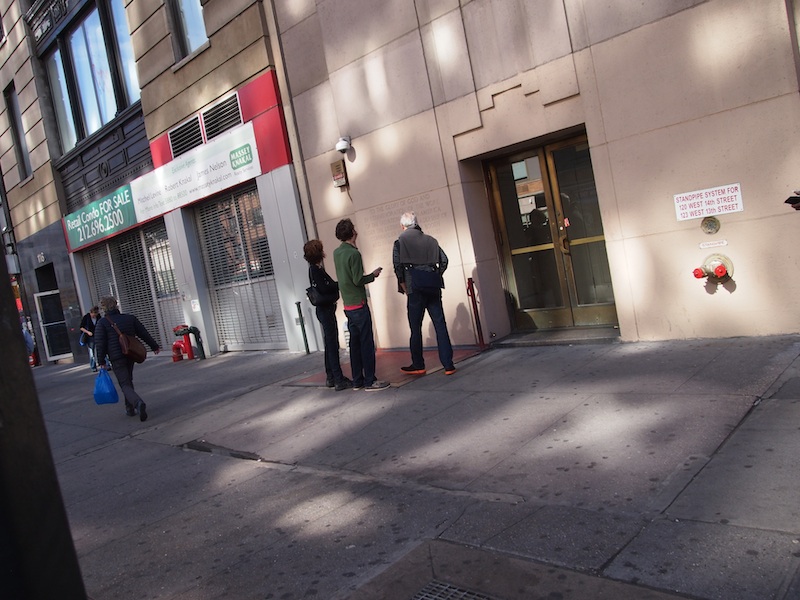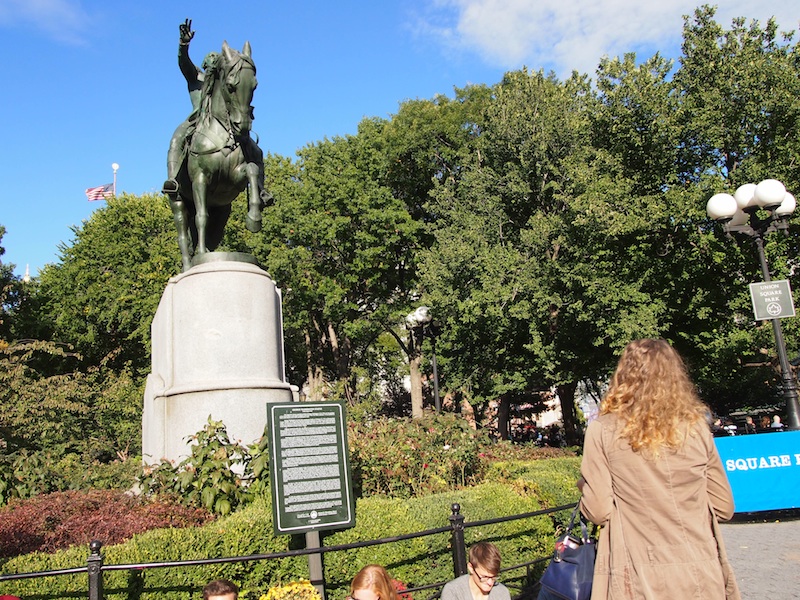Art in Odd Places’s (AiOP) 2013 festival is in full swing! Until October 20th, 14th Street will be taken over by this year’s artists, each presenting works that relate to the theme of NUMBER. Looking at them in both the literal and abstract, the works are setting out to show how numbers bind, define, challenge, aid, and serve as ever-present entities in each and every one of our lives. A.E. Souzis’s “Architextour” takes an interactive approach linking numbers with history.
“Architextour.” Photo courtesy of Joel Hamburger.
“Architextour” is an historical text message walking tour that takes places along 14th Street. Participants are told to look out for specific numbers along the way and then text them to a phone number provided; if they do find the correct number then they will be rewarded with a follow up text explaining the history of that area along the stretch of the street.
AiOP was able to talk with Souzis about what inspired her to create this participatory promenade:
Can you tell us a little bit about yourself and the kinds of work that you do?
I am a writer and an interdisciplinary artist. I primarily write nonfiction and develop site-specific works that explore public space, alternative and underground histories, and real-life networks of power. Some of my recent projects include a screenplay version of a WikiLeaks telegram (as if the diplomatic cable was a Hollywood film) and a print and audio walking tour of Wall Street exploring the 2008 financial crisis. I’m really fascinated with hybrid storytelling– I also write a blog called Joyful Spheres on this topic – and how mixing different genres, mediums and technologies can change the way we experience stories and, by extension, our understanding of the world around us. I am particularly interested in site-specific storytelling, especially projects that use mobile technology, because I find space enhances a narrative experience, offering an extra layer of complexity and unpredictability that engages the audience more.
What attracted you to this year’s AiOP festival?
As a lifelong New Yorker, I have long been fascinated with 14th Street as a neighborhood that straddles New York City’s distinct uptown and downtown cultures. Since a big part of my practice is designing site-specific projects that explore New York City’s history, I jumped at the chance to create a walking tour along 14th Street for this year’s Art in Odd Places festival. AiOP’s theme attracted me because numbers, which often refer to dates and locations, can be used as a simple yet memorable way to tell the story of a place throughout time. Inspired by this, I designed Architextour, a self-guided, interactive text message walking tour of 14th Street.
“Architextour.” Photo courtesy of Joel Hamburger.
How are you interpreting the theme number?
To me, numbers represent concrete things in the city (excuse the pun): location (addresses) and time (dates). In my project Architextour, numbers are used in an interactive, game-like way to draw people into the history. As part of the tour, participants are asked to find a number somewhere at each site (not the address) and text that back to the phone number provided. If they reply with the right number, they are rewarded with a series of texts describing the history and importance of the site. The purpose of this is to require people to look really closely at these sites – perhaps more than they would have otherwise – and see how the numbers visible there today connect to the sites’ past.
What challenges did the theme present you when creating works for public space?
I would say AiOP’s theme of number presented two challenges specific to my project: first, finding historically important sites along 14th Street that display numbers that are not part of their address. The second challenge I encountered was narrowing down that list to the most interesting ones!
What excites you about the prospect of presenting this work?
I am really excited to experiment with text messaging, a normally terse and distracting communication medium, and see if it can be an effective site-specific storytelling form. In particular, I am hoping to see whether the text message’s constraints – its 160-character limit and abbreviated slang – can be reappropriated in a walking tour to help convey the history of a place in a brief but memorable way. I am also interested in exploring how the game-like element in Architextour, the required search for numbers at each site, may help people to pay more attention to their environment while also revealing how cell phones may distract them from it.
“Architextour.” Photo courtesy of Joel Hamburger.
How has adapting your work to 14th street affected your process?
Well, every walking tour is shaped by the neighborhood it is set in. So my process in designing Architextour was based on the neighborhood’s geography, as well as its history. In this case, 14th Street is a long, major thoroughfare, so while it was fairly easy for me to choose a path for the walking tour, I had to continually answer questions like: should the tour progress east to west? Or west to east? How will this path make sense in terms of the larger story I am telling about the neighborhood? And does each site along the path help contribute to this narrative?
Have you come to learn anything new about 14th street while formulating your work?
Yes, quite a bit! When I developed Architextour, I knew about some history – like the many political rallies in Union Square Park – but I learned a lot more while researching the area (much of which I didn’t have room to include in the tour). For example, I learned that many artists and writers had lived or worked along 14th Street, a fact that surprised me because I always thought the area was primarily a commercial strip. Even Marcel Duchamp had a studio at 210 14th Street in the 1940s.
“Architextour.” Photo courtesy of Joel Hamburger.
Was there any specific number that spoke out to you when formulating your work? Why?
There were so many numbers I encountered that no specific one really spoke out to me. But I will say that the 1930s kept jumping out at me during my research. Not only were a surprising number of buildings constructed during that period, but many politically significant events – like strikes, rallies and union organizing – all occurred in that decade.
Has formulating this work changed any preconceived notions you had about numbers?
While I would not say it completely changed my preconceived notions about numbers, Architextour has made me acutely aware of their ubiquitous presence in public space. While researching the tour, I spent a lot of time walking up and down 14th Street and found myself noticing every single number displayed around me – not just dates or addresses but phone numbers, buzzer numbers, signs etc. It makes me realize how important numbers are in city planning and how little we generally notice them when we walk around.
“Architextour.” Photo courtesy of Joel Hamburger.
Did you take anything from this experience that you plan on applying to future works?
My work in designing Architextour has taught me a lot about the history of 14th Street as well as how to incorporate mobile technology and simple game interactions in a walking tour. I definitely plan to experiment more with text messaging as a mobile storytelling device in future site-specific projects.






